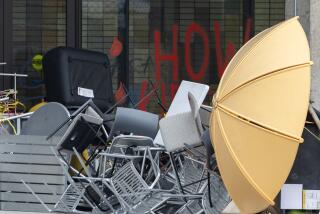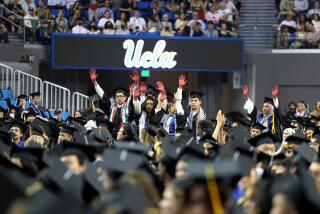8-Story Leap Kills Cal State Student : Apparent Suicide at Humanities Building is 5th
Tragedy struck the Cal State Fullerton campus again Wednesday when a freshman biochemistry student jumped to her death from the top of the Humanities Building, the fifth apparent suicide from that structure in eight years.
The death occurred just two days after campus officials received financing for balcony grilles to block access from the top floors of the building, and six days after a seminar on suicide prevention was held on campus in response to the last suicide.
Subject of Petition Drive
The eight-story Humanities Building, dubbed âthe Golden Gate Bridge of Orange Countyâ by campus habitues, had been the subject of a petition drive by students and faculty after the suicide of a former sociology student in March. But efforts to finance a network of barrier grilles on the balconies that overlook a large concrete plaza were not successful until this week.
âItâs ironic and heartbreaking,â said Sal Rinella, the universityâs vice president for administration. âI feel as though we moved as rapidly as we could. But in my heart of hearts, I wish we could have moved faster. I think everybody does.â
The dead woman was identified as Luom Thi Pham, 20, of Santa Ana. Her body was found at 6:30 a.m. Wednesday by a university custodian and identified when coronerâs investigators found a car key that was traced to a Toyota in the parking lot.
Investigators found a pair of lavender pumps on the eighth-floor balcony.
Only a week ago, on Oct. 24, campus officials sponsored a suicide-prevention conference for student services advisers and department chairmen. The seminar was planned after the March suicide of Gordon Franklin McMahon, 36, a former sociology student.
The conference attempted to help campus professionals recognize suicide-warning signals and learn how to deal with them, according to Charles Buck, associate vice president for student services.
âWith a campus like this, thatâs this big, with people coming and going a lot, you need to emphasize the need for relationships--between the faculty and students, the clerical staff and students--so that every individual understands that they have the responsibility to respond when they see what might be a problem,â Buck explained, adding:
âMaybe itâs just telling a student you can see somethingâs wrong, and is there anything you can do to help?â
The tragedies that have struck the 26,000-student campus in recent years have left permanent scars. Besides the four others who have jumped to their deaths from the humanities building since 1977--three former students and an employee of the campus media center--students and faculty have weathered:
- A shooting spree in the library in 1976, when disgruntled custodian Edward Charles Allaway gunned down nine people, killing seven.
- The shooting death of physics professor Edward Lee Cooperman in October of 1984. Minh Van Lam, a student, was convicted of involuntary manslaughter and sentenced to four years in prison.
- The arrest of philosophy professor Richard L. Smith in May of last year on charges that he murdered the husband of a former student. Smithâs trial is pending.
- The death of remedial English professor Priscilla Oaks a little more than a month ago in an automobile accident.
- The bombing death earlier this month of Alex Odeh, director of the California chapter of the Arab-American Anti-Discrimination Committee and a part-time professor of Arabic at Cal State Fullerton.
After the death Wednesday, dozens of students stood quietly in the plaza outside the humanities building, peering at the top-floor balcony that stretched almost into the lead-gray sky. By noon, a small plastic glass with two red roses had appeared where the victimâs body had fallen.
âItâs very tragic,â said campus president Jewel Plummer Cobb. âIt must make everyone feel very depressed at the time. Whether itâs sustained or not--I hope not.â
John Hoos, a math major, said the incident was the first topic of discussion in his 8 a.m. numerical analysis class. âEverybody was kind of joking about it, about putting a target down here for people to land on,â he said.
âThe campus is so big here, thereâs so many students that something like this never hits home,â Hoos said. âItâs not personalized; itâs too big. I work full time; I take three classes here; I come and I go and I really donât know anybody.â
Franklin Stuart, a graduate student who works on the ground floor of the Humanities Building, said: âItâs pretty hard on the people in this office.â
Stuart said he âspent a good deal of the morning hoping that sidewalk would dry so I could think of something else . . . . I saw that (the victimâs) blouse was open a little, and for some reason it occurred to me that she got up, got dressed, came down here and jumped off a building.
âYou know, sometimes I feel like having these buildings open is tantamount to having a loaded gun.â
Others also expressed resentment over the easy access to top-floor balconies.
âEvery time this has happened, students and faculty have badgered the administration to do something about it,â complained psychology professor Ernest Dondis. âThey talk the problem into nonexistence; by the time they get through with their administrative jargon, there is no problem,â he said. âWhat can I say? It is depressing for a while. There will be a great deal written about it in the Daily Titan (the campus newspaper) tomorrow; people will talk about it for a few weeks, and then they will forget. But some of us will not forget.â
Said Charles Buck, associate vice president for student services: âMy first thought when I heard about it this morning was anger. I was angry that money got in the way. The plan was to get it (the protective grille work) done early, and my first reaction was: âMy God, why didnât they get the damn stuff up when they were supposed to?â â
Cobb wrote to the chancellorâs office March 25, shortly after the last suicide, requesting $7,500 for a study to determine how best to protect against future suicides at the building. The money was approved, and the study completed in mid-July showed that three-quarter-inch grille work was the best way of enclosing the balconys. The chancellorâs office notified campus officials only on Monday that $48,000 in emergency funds had been approved for the construction work.
Rinella announced Wednesday that both the Humanities Building and the Science Building, which also has outdoor balconies, will be staffed with an extra security officer in the early-morning hours--when the two most recent suicides have occurred--until the grilles are installed.
The buildings, usually unlocked at about 6 a.m., will be kept locked until 7:15, Rinella said. While campus officials estimate the grilles should be installed by the mid-year break in January, Rinella said the university will try to speed that process as much as possible.
âFrom my perspective, we moved as fast as we could. However, I realize that on a matter like this, that any delay at all between a solution and the time the last occurrence took place would be considered unfortunate,â Rinella said.
âI think the other thought I have on this is that suicide is an ultimate irrational act, and when something like this occurs, it elicits a lot of questions in which people are trying to find, understandably, rational solutions or rational reasons as to how this occurred or how we could have prevented it. In fact, itâs very difficult to pinpoint exactly what could have been done in order to have prevented this young woman from taking her life,â Rinella said.
Coronerâs and campus investigators said Pham left no notes, and there were no witnesses. Chemistry department chairman Robert Belloli said the victim had been scheduled to take a test in her freshman chemistry class Wednesday and that her overall academic record was unremarkable.
âHer grades werenât spectacular, but they werenât anything to worry about,â he said. âIt wasnât like she was flunking out or anything.â
Tan Pham, her brother and a fellow biochemistry major at Cal State, said the family was mystified. âNothing happened in the family. I donât know why she did it. Maybe it was something outside that I donât know about.â
Luom Thi Pham, who graduated from Santiago High School in Garden Grove a year ahead of Tan Pham, lived with her family and was in her second year at Cal State Fullerton, her brother said. âShe seemed to be doing OK in school. Every night she would just be doing her homework.â
Student body president Tracey Stotz said Wednesday that the student government is planning to erect a commemorative artwork âfor all the individuals who died in the university community.â
The piece, probably to be commissioned from a graduate art student, would have space at the foot for flowers, but it would not be dedicated to any particular individuals. âThat way, it would mean different things to different people,â said Stotz. âWeâve all been through a lot.â
More to Read
Sign up for Essential California
The most important California stories and recommendations in your inbox every morning.
You may occasionally receive promotional content from the Los Angeles Times.










